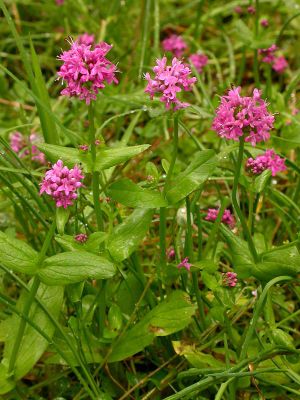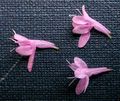Difference between revisions of "Plectritis congesta"
m (Tag: VisualEditor) |
(Tag: VisualEditor) |
||
| Line 1: | Line 1: | ||
| − | * Latin Name: ''Plectritis'' ''congesta'' | + | *[[File:PLECCON1.jpg|thumb|Photo: Ben Legler, 2004]]Latin Name: ''Plectritis'' ''congesta'' |
* Family: Valerianaceae | * Family: Valerianaceae | ||
* Common Names: rosy plectritis, sea-blush | * Common Names: rosy plectritis, sea-blush | ||
* CODON: PLECON | * CODON: PLECON | ||
| − | |||
| − | |||
==Taxonomy== | ==Taxonomy== | ||
*Kingdom: Plantae | *Kingdom: Plantae | ||
| Line 48: | Line 46: | ||
==Photo Gallery== | ==Photo Gallery== | ||
<gallery> | <gallery> | ||
| − | File: | + | File:PLECCON2.jpg|Photo: Ben Legler, 2004 |
| − | File: | + | File:PLECCON3.jpg|Photo: Ben Legler, 2004 |
| − | File: | + | File:PLECON4.jpg|Young growth, photo courtesy of CNLM |
</gallery> | </gallery> | ||
==References== | ==References== | ||
<references /> | <references /> | ||
Revision as of 17:26, 2 June 2020
- Latin Name: Plectritis congesta
- Family: Valerianaceae
- Common Names: rosy plectritis, sea-blush
- CODON: PLECON
Contents
Taxonomy
- Kingdom: Plantae
- (unranked): Angiosperms
- (unranked): Eudicots
- (unranked): Asterids
- Order: Dipsacales
- Family: Valerianaceae
- Genus: Plectritis
- Species: P. congesta
Description
General: Annual herbs, the stem usually simple, 1-6 dm. tall, the herbage nearly glabrous throughout.
Leaves: Leaves opposite, distant, entire, 1-6 cm. long and 3-22 mm. wide, the lowermost ones spatulate or obovate and short-petiolate, the others oblong to elliptic and sessile.
Flowers: Inflorescence congested, sub-capitate; calyx obsolete; corolla united, two-lipped, bright pink to white, 2-8 mm. long, with a well-developed, thick spur; stamens 3; ovary inferior, apparently 1-celled, since two of the 3 cells are sterile.
Fruit: Fruit a dry carpel, 2-4 mm. long, the convex side keeled, with or without lateral wings.
Bloom Period
April - June
Distribution
Mostly west of the Cascades, Vancouver Island, British Columbia to California
Habitat
Ecological Setting Open, vernally moist meadows and slopes, sea level to moderate elevations in the mountains. Coastal bluffs, rocky slopes, meadows, grassy and mossy areas. Soil Texture Sandy and gravelly Nutrients Soil Reaction / Salinity Moisture Regime Moist mostly but can be found in drier places. Shade Tolerance Prefers mostly sunny or full sun
Uses
Propagation
Seeds were sown into cone-tainers filled with Sunshine # 1 (a soil-less peat-based media) amended with micro-nutrients (Micromax) and a slow-release fertilizer (Osmocote 14-14-14.) Flats were placed in greenhouse set at moderate temperatures (70 degree days/50 degree nights.) Seeds germinated within one to two weeks. 60% germination occured.
Fruit and Seed Collection and Extraction Collection: Plant develops two different fruits/seeds--fruit polymorphisms. Both types of seed can be easily shaken into an envelope or bag when ripe. All the plants do not ripen at the same time. Special care must be taken when cleaning seed as their shape and size differs.




